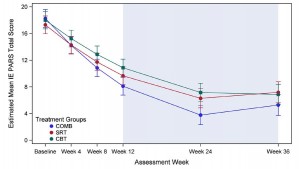The Child/Adolescent Anxiety Multimodal Study (CAMS) represents one of the largest and most comprehensive studies to date on the comparative efficacy of different types of treatment for anxiety disorders. In the original NIMH funded study, a total of 488 youth with various combinations of separation, generalized, or social anxiety disorder were randomized to treatment groups consisting of 12 weeks of cognitive-behavioral therapy, medication with sertraline, combination medication and CBT, or pill placebo. At the end of the study, combined treatment was found to be superior to either active treatments alone and all treatments were superior to placebo.
A new study now describes the participants’ level of functioning and symptoms approximately 6 months later. In the interval from study completion to follow-up, those who responded at the end of the original study were given 6 monthly booster sessions in their assigned modality. They were, however, permitted to add other types of treatment. Those that had originally received placebo were offered treatment if they did not respond to placebo, but were not included in these follow-up analyses.
One piece of good news overall was that, across all treatment groups, about 80% of youth who had originally responded to treatment kept their response at follow-up. In terms of group differences, those in the combined group continued to do somewhat better than those in the CBT alone or sertraline alone groups on quantitative assessments of symptoms, although with categorical designations of responders versus nonresponders, the rates did not differ statistically. This was due to the CBT and sertraline groups increasing their response rate (to around 70%) while the combined group kept its response level roughly the same (around 80%). The CBT alone and sertraline alone groups continued not to differ from each other.
The authors concluded that successful treatment of anxiety disorders results in a sustained response over the next 6 months for most individuals. They speculated that the lack of separation between groups over time may be related to the naturalistic design and the greater use of combination medication and therapy treatment among many subjects.
These results offer solid evidence that the vast majority of youth with anxiety disorders can improve significantly with different treatments and can maintain those gains at least over the next 6 months. Their finding that the separations between groups erodes somewhat over time mirrors similar studies of other disorders where patients are followed naturalistically after the randomization stops. Overall, there is evidence that combination treatment can be the fastest path to improvement, although single modality treatment using evidence based practices may catch up. Current treatment recommendations continue to be that childhood anxiety disorders should be treated with cognitive-behavioral therapy on its own or with medications for more severe cases.
Piacentini J, et al. 24- and 36- week outcomes for the child/adolescent anxiety multimodal study (CAMS). JAACAP 2014;53(3)297-310
Tags: cbt, child anxiety, child anxiety multimodal study, sertraline

